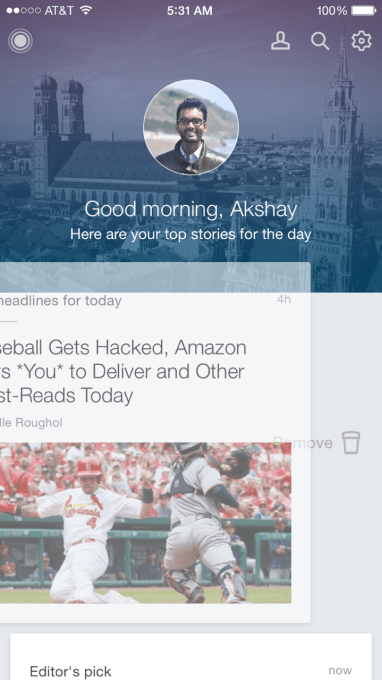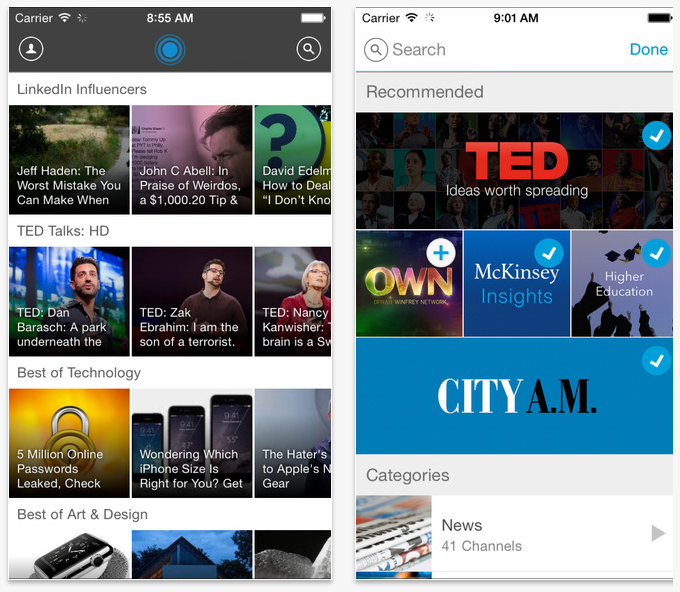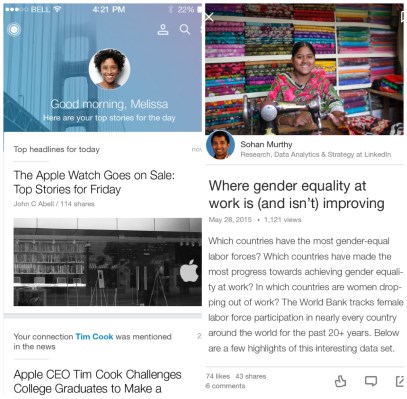The arrival of Apple’s News app, question marks over the future of Flipboard, and Facebook’s news publishing moves are putting a renewed focus on how we as consumers read news online and how that will be developing in the future. Now one of the earlier movers in the world of news aggregation is making its own updates to try to answer that question.
Pulse, the news reading app founded back in 2010 and acquired by LinkedIn in 2013, is today releasing a major overhaul of its iOS and Android apps — the first major updates since getting bought, in fact.
 The app will now feature a cleaner UI that borrows a swipe-left to reject/swipe-right to save gesture borrowed from popular apps like Tinder, but perhaps more importantly it will provide a whole new approach to how it helps you discover news.
The app will now feature a cleaner UI that borrows a swipe-left to reject/swipe-right to save gesture borrowed from popular apps like Tinder, but perhaps more importantly it will provide a whole new approach to how it helps you discover news.
Rather than simply relying on getting you to find and follow the news feeds that you read already and then delivering them to you in an RSS-style feed, Pulse now “reads” you: based on your LinkedIn connections, what you are reading and commenting on in LinkedIn; and where you work, Pulse now provides you with a selection of news based on your LinkedIn “professional graph,” as the company likes to describe its mix of resume details, network connections and content that you choose to read on its platform.
“We came to a conclusion just being a reader and organising that is not enough,” Akshay Kothari, Pulse’s co-founder who has led the development of the new apps, told me in an interview about some of the motivations behind the update. “We felt that our device processing speeds are getting better, and simply optimizing the aggregation and reading” is hard to remain compelling.
The news fed into Pulse comes from some 250,000 sources, and will include not just a selection of news and magazine sources, but content from LinkedIn’s own publishing effort.
You can still add specific publications into the mix alongside this, and for those who are using the current Pulse app, you can continue to do so until the end of this year.
Kothari tells me that rebuilding the app in this way had always been in the startup’s sights. “We knew 30 million people were using the app, but we didn’t know their backgrounds or who they were connected to” to use that information to serve more relevant news, he said in an interview. “This was why LinkedIn was a perfect fit. No other network has a deep identity data like LinkedIn does.”
All the same, the changes are very much in line with how LinkedIn has been trying to develop its wider platform. Taking the service beyond a place where people simply go to look for new job recruitment, it wants people to spend more time on the platform to help LinkedIn grow other parts of its business around advertising and premium content — and area that will be developed, for example, by way of its recent Lynda.com online learning acquisition.
On the subject of ads, Kothari says the company has yet to come to a decision on how these will appear in Pulse, which for now is totally ad-free. “There is a team focused on building the ad experirence, so if at any point we wanted to integrate them, we could,” he says. “But right now the aim is to deliver a useful Pulse experience.” He adds that there is “no strict timeline” on when they will come — leading me to think that ultimately, they will appear.
Pulse has never officially updated its user numbers since the LinkedIn sale. Asked for current figures, a spokesperson says it’s just been “growing steadily” since it was bought. But some of the struggles that other apps like Prismatic and Flipboard have had growing audiences for their news aggregation services points to one of the big challenges in the space: we may all read news, but we are not necessarily news nerds.
The new Pulse tries to get around that by doing more of the work for you. From sign-on, users are presented with that mix of articles based on their profiles, doing away with the need for lengthy “onboarding.” In that regard, this is not unlike the new app out of Japan, SmartNews, which also tries to take away as much user-selection as possible in its initial encounters.
For reference, the older Pulse app had more of an emphasis on you selecting what you wanted to read in the app, before you could use it, and then organised it by categories for you:

This new feed of news, meanwhile, will be a mix that could include news about your own company, but could just as easily include news about a company that is competitive to yours. It will feature not only stories highlighting your network of contacts, but stories people in that network may have flagged themselves. All fine and well, as long as you and your network contacts are active LinkedIn users who keep your profiles reasonably up to date.
Another notable aspect of this, Kothari points out, is that now Pulse will be automatically incorporating LinkedIn published posts into the longer feed of news. This is progression on a time when those posts were incorporated as a separate category that you could in theory choose to ignore. This could annoy some readers who are not interested in LinkedIn published posts, since you can’t remove them from the feed. One way perhaps of minimizing their appearance would be to “swipe left” on them to reject.
While the new Pulse feels like a far cry from a place where you used to be able to read a mix of leisurely and work-oriented content, its differentiation from other news apps like Apple’s and Flipboard’s could help it stand out better and position itself as more useful.
Still, ultimately, what people really want in their feeds may not be always obvious from their LinkedIn profiles. That will be a question that might also be relevant for those who will be working on maintaining Pulse going forward.
Kothari notes that LinkedIn has a large “relevance team” that wrote the algorithms for how news associates with your specific social graph, but there will also be “human editors” based out of New York helping to select and hone how content feeds develop — an approach that Apple will apparently also be taking with its News app. For LinkedIn, Kothari says a “human touch” will manifest in the form of editors’ picks and headlines of the day.
